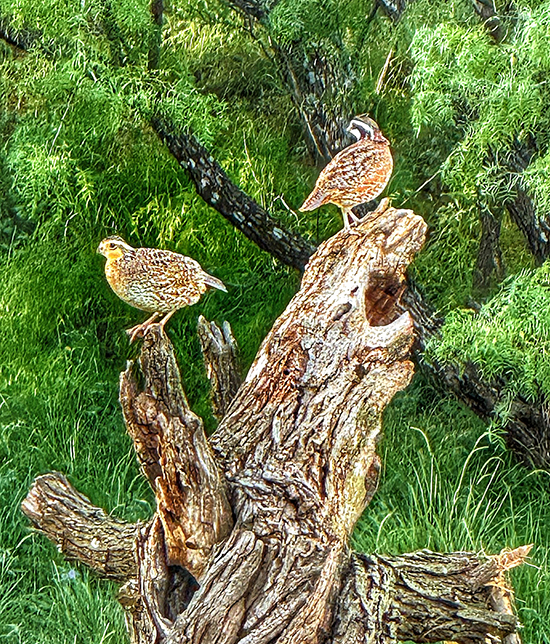
A mated pair of bobwhite quail chose this weathered mesquite stump to rest upon and scout for danger. The cock is at the highest point and the hen is lower. Science reports that 80 percent of the adult quail population will not survive the winter regardless of hunting. Severe winters, disease, drought, extremely hot summers, and depredation account for much of the loss.
(Photo by Willie Krecek, ©2025)
by John Jefferson
An old love song’s lyrics go, “Birds on the wing/ start to sing again/that old melody.”
Spring is time for birds calling for mates. The Central Flyway of migratory birds returning to the North passes right through Texas. Those birds and the many that stay here year around have plenty to sing about. Most of it is breeding-related.
My favorites are the mating calls of mourning doves, whitewings, and the diminutive but amazingly loud Carolina wrens.
My introduction to the spring birdcall music originated from first hearing flights of geese arise from their roost in the dark with a cacophony of loud squawks that could almost sound like the entire Apache Nation coming over the hill in full war paint. Laying on cold, marsh ground in the dark on a goose hunt floods your imagination with wonderment and thankfulness. That’s a winter thing but it carries over into early spring along the Coast.
But the day that captivated me came on a spring turkey hunt in Lampasas County. The woods around me were jampacked with birds I couldn’t see, but — MAN! – could I hear them! It was delightfully deafening. I never fired a shot but will always remember hearing a thousand or more songbirds vocally seeking love and affection.
The migration is over for the most part. Whooping cranes, sandhill cranes, and other migratory birds left to return to roost sites in the North.
Texas has enough resident water birds, including some sandhill cranes, nesting along the coast to offer a unique experience. Captain Tommy Moore operates Whopping Cranes Tours out of Rockport/Fulton and comfortably carries clients to see multiple species nesting on the rookery islands into June. His boat is comfortable and accommodating to birders and others. Even has restrooms! Reach him at (877) 892-4737.
Hunters, though, are worried about quail. They’ve been declining. But bobwhites have been paired since the end of hunting season. Research by TPWD shows quail need mild winters, few short freezes, a carryover of adult birds, plenty of grassy cover, and moist soil to nest over in order to have a hatch that survives, according to Dr. Jerry Cooke, retired wildlife biologist who analyzed the data.
John McLaughlin, TPWD’s quail leader until promoted upward says the Panhandle, Rolling Plains, and South Texas Plains have been blessed with rain which supplied cover, food, and moist soil for hatchings. His successor, Patrick Shutz, agrees and said landowners assured him of a good carryover of adult quail from 2024. And last winter was mild.
Conditions are in place for a good hatch. Some have already been reported.
But many things can go wrong, like disease, a devastatingly hot summer, extended drought, and nest depredation – some by predators and some accidentally– like clumsy armadillos stumbling over eggs.
But considering Texas’ history of up and down cycles of quail populations and the foregoing list of needs for such success, PLUS current favorable conditions, I expect to hear another of my favorite bird calls this summer: “Bob – WHITE!”
It’s music!
JJ




